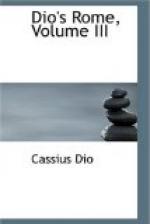[-30-] This testudo and the way in which it is formed deserve a word of explanation. The baggage animals, the light-armed troops, and the cavalry are marshaled in the center of the army. Those infantrymen who use the oblong, hollow, grooved shields are drawn up around the edges, making a rectangular figure; and, facing outward with spear-points projecting,[52] they enclose the rest. The other infantrymen, who have flat shields, form a compact body in the center and raise their shields above themselves and above all the rest, so that nothing but shields can be seen in every part of the phalanx alike and all the men by the density of formation are under shelter from missiles. It is so marvelously strong that men can walk upon it, and when ever they get into a hollow, narrow passage, even horses and vehicles can be driven over it. Such is the method of this arrangement, and this shows why it has received the title of testudo,[53]—with reference to its strength and to the excellent shelter it affords. They use it in two ways: either they approach some fort to assault it, often even enabling men to scale the very walls, or where sometimes they are surrounded by archers they all bend together,—even the horses being taught to kneel and recline,—and thereby cause the foe to think that they are exhausted; then, when the others draw near, they suddenly rise, to the latter’s great alarm.
[-31-] The testudo, then, is the kind of device just described. As for Antony, he suffered no further harm from the enemy, but underwent severe hardships by reason of the cold. It was now winter, and the mountain districts of Armenia, through which, as the only route open to him, he was actually thankful to be able to proceed, are never free from snow and ice. The wounds, of which the men had many, there created especial discomfort. So many kept perishing and were continually rendered useless for fighting that he would not allow reports of each individual case, but forbade any one to bring him any such news; and although he was angry with the Armenian king for deserting them, and anxious to take vengeance on him,




